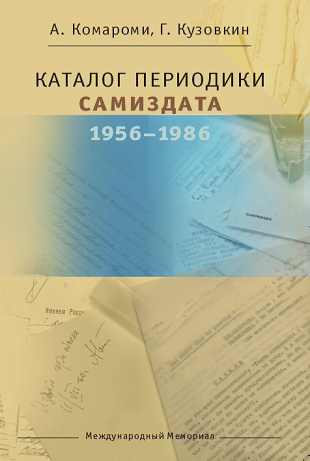
Komaromi, A., and G.V. Kuzovkin. Katalog periodiki Samizdata, 1956-1986 [Catalog of Samizdat Periodicals, 1956-1986]. Moscow: International Memorial, 2018. 168 pp.
The directory is the first to compile information on the free periodical press in the post-Stalin USSR (1956–1986).
The panoramic scope of the Catalog is one of the guide’s main strengths. No one had previously undertaken the ambitious task of presenting the free periodical press from across the entire Soviet Union. Thus, the Catalog’s preeminence is indisputable. The guide’s thoroughness is also noteworthy: it consolidates data from archives in Russia and several other countries, both near and far.
The appearance of the catalog was the result of international scholarly collaboration. It was prepared by the philologist Ann Komaromi (University of Toronto) in partnership with “Memorial”—specifically, its research program, “History of Dissent in the USSR.”
Before Gorbachev’s Perestroika, publishing an independent press in the USSR was a risky business, as the party leadership sought to monopolize the flow of information. Unsanctioned periodicals were seen as harbingers of organized opposition and were therefore under special scrutiny by the authorities. Independent journalistic initiatives required great determination. Now, thanks to the Catalog, we know there were more than three hundred such initiatives: journals, collections, almanacs, and informational bulletins were all published.
The Catalog first appeared on the University of Toronto website in 2011 and, since 2015, has been part of an electronic archive—a research portal also created by A. Komaromi. The Russian versions of the Catalog (both print and electronic) were created under the direction and scholarly editorship of Gennady Kuzovkin.
The guide is addressed to historians and researchers of Soviet society. The Catalog fills a significant gap in the history of national journalism and the literary process during the three decades after Stalin. It will be particularly useful for studying the history of dissent and samizdat activity. For the second half of the 20th century, there is a deficit of reference guides and fundamental works based on extensive empirical data, which is why the first monograph, “The History of Dissent in the USSR,” written by Lyudmila Alexeyeva (1927–2018), remains relevant. The print edition of the Catalog opens with a foreword by her.
For all reference guides, especially those published for the first time, clarifications and additions are invaluable. Moreover, this is not just about this specific Catalog, but about preserving memory. Therefore, we invite members of Memorial to examine the Catalog personally and, if possible, to show it to historians, archivists, museum staff, and teachers—participants in the School Competition. Of course, advisory support will be provided to all who express interest. Colleagues from St. Petersburg (the “Memorial” Research and Information Center / Iofe Foundation) and Kharkiv (Kharkiv Human Rights Protection Group) have already contributed to the book’s preparation, and although our words of gratitude are already in the catalog, the compiler and scientific editor are pleased to reaffirm them in this short note.
For many city dwellers, memories of samizdat are part of their family history, which, fortunately, has not yet receded to an unreachable historical distance. For the study of the free press, periodicals still unknown to scholarship and information about the publications already included in the Catalog are equally interesting. These may have been preserved in private archives. For the history of samizdat activity, data on when and how copies came into the possession of their keepers, their subsequent circulation, and so on, are crucial. Photographs of the cover, title page, and table of contents, as well as any illustrations, will greatly aid in creating a correct archival and bibliographic description.
We will venture not just to suggest, but to assert: clarifications and additions will inevitably arise. We have already received information about two publications from St. Petersburg and Riga. The authorship of all clarifications, corrections, and additions will be duly credited. In both the electronic and print versions of the book (in new editions), words of thanks will be included for contributions to the Catalog's preparation.
Gennady Kuzovkin, “Memorial” Research and Information Center, Moscow